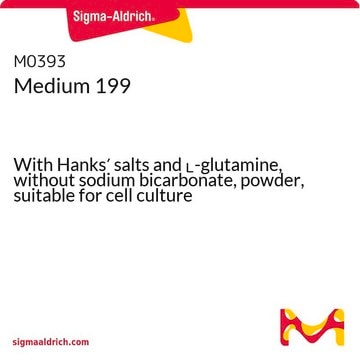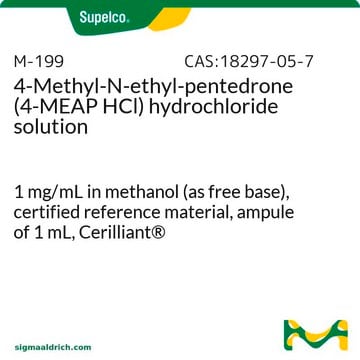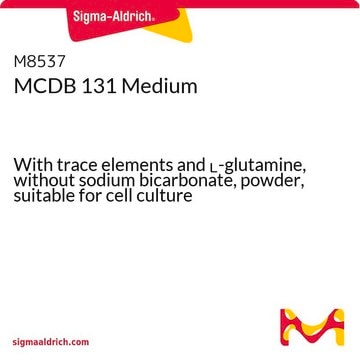M3769
Medium 199
Modified, with Earle′s salts, without L-glutamine, sodium bicarbonate, and phenol red, powder, suitable for cell culture
Synonym(s):
M199 Medium, TCM 199
Sign Into View Organizational & Contract Pricing
All Photos(1)
About This Item
UNSPSC Code:
12352207
NACRES:
NA.71
Recommended Products
Quality Level
form
powder
technique(s)
cell culture | mammalian: suitable
components
L-glutamine: no
phenol red: no
HEPES: no
sodium pyruvate: no
Earle’s salts (5% CO2): yes
NaHCO3: no
shipped in
ambient
storage temp.
2-8°C
Looking for similar products? Visit Product Comparison Guide
General description
Medium 199 is a combination of vitamins, amino acids, and other factors that were originally developed as a completely defined media formulation for the culture of primary explants. This medium, when properly supplemented has broad applicability, particularly for non-transformed cells. Medium 199 is widely used for vaccine production, in vitro cultivation of primary pancreatic explants, and lens tissues.
Application
Medium 199 has been used:
- to culture the primary human umbilical vein endothelial cells (HUVECs) for use in cell viability assay
- to flush the uterine horn of gilts to recover day 12 conceptuses from uteri
- to culture the peritoneal cells and immortalized human mesothelial cells (MeT-5A and ATCC-CRL-9444)
Quantity
Formulated to contain 9.4 grams of powder per liter of medium.
Reconstitution
Supplement with 0.1 g/L L-glutamine, 2.2 g/L sodium bicarbonate.
also commonly purchased with this product
Product No.
Description
Pricing
supplement
Storage Class Code
13 - Non Combustible Solids
WGK
WGK 1
Flash Point(F)
Not applicable
Flash Point(C)
Not applicable
Choose from one of the most recent versions:
Certificates of Analysis (COA)
Lot/Batch Number
Don't see the Right Version?
If you require a particular version, you can look up a specific certificate by the Lot or Batch number.
Already Own This Product?
Find documentation for the products that you have recently purchased in the Document Library.
Customers Also Viewed
Diane G Edmondson et al.
mBio, 12(1) (2021-02-25)
The bacterium that causes syphilis, Treponema pallidum subsp. pallidum, has now been cultured in vitro continuously for periods exceeding 3 years using a system consisting of coculture with Sf1Ep rabbit epithelial cells in TpCM-2 medium and a low-oxygen environment. In
Luciana de Lima Ferreira et al.
PLoS neglected tropical diseases, 14(12), e0009015-e0009015 (2020-12-29)
Trypanosoma rangeli is a non-pathogenic protozoan parasite that infects mammals, including humans, in Chagas disease-endemic areas of South and Central America. The parasite is transmitted to a mammalian host when an infected triatomine injects metacyclic trypomastigotes into the host's skin
Klaus Kratochwill et al.
Nephrology, dialysis, transplantation : official publication of the European Dialysis and Transplant Association - European Renal Association, 27(3), 937-946 (2011-08-23)
Exposure of mesothelial cells to peritoneal dialysis fluids (PDF) results in cytoprotective cellular stress responses (CSR) that counteract PDF-induced damage. In this study, we tested the hypothesis that the CSR may be inadequate in relevant models of peritoneal dialysis (PD)
Hung-Chang Chou et al.
Colloids and surfaces. B, Biointerfaces, 208, 112136-112136 (2021-10-11)
Nitric oxide (NO) is a potential therapeutic agent for various diseases. However, it is challenging to deliver this unstable, free-radical gaseous molecule in the body. Various nanoparticle-based drug delivery systems have been investigated as promising NO carriers without detailed characterization
J L N Barratt et al.
Parasitology, 137(13), 1867-1878 (2010-07-09)
Dientamoeba fragilis is a pathogen of the human gastrointestinal tract that is a common cause of diarrhoea. A paucity of knowledge on the in vitro cultivation and cryopreservation of Dientamoeba has meant that few studies have been conducted to investigate
Our team of scientists has experience in all areas of research including Life Science, Material Science, Chemical Synthesis, Chromatography, Analytical and many others.
Contact Technical Service









